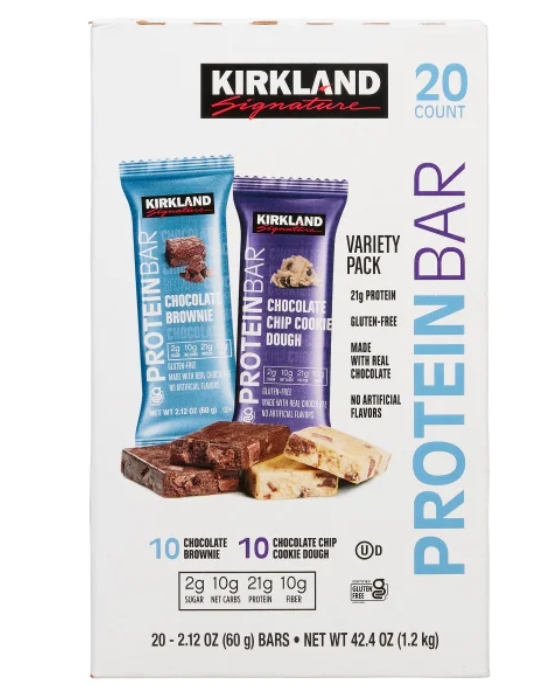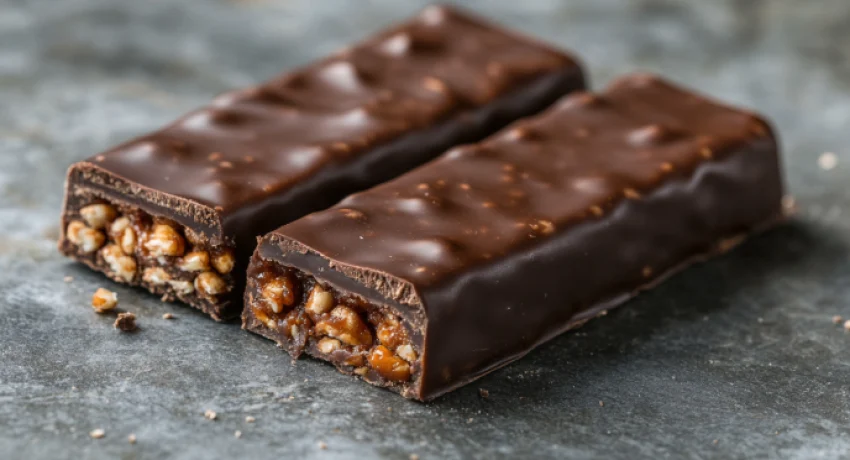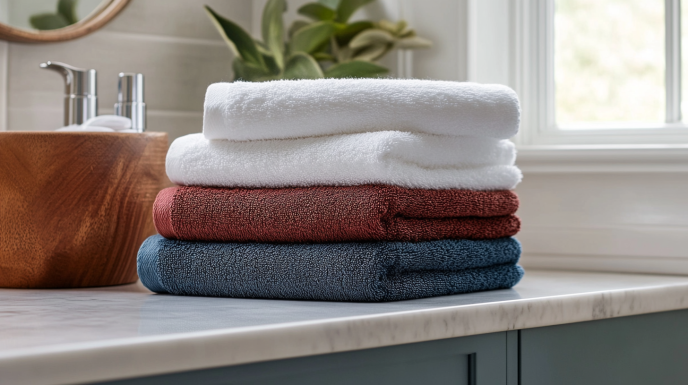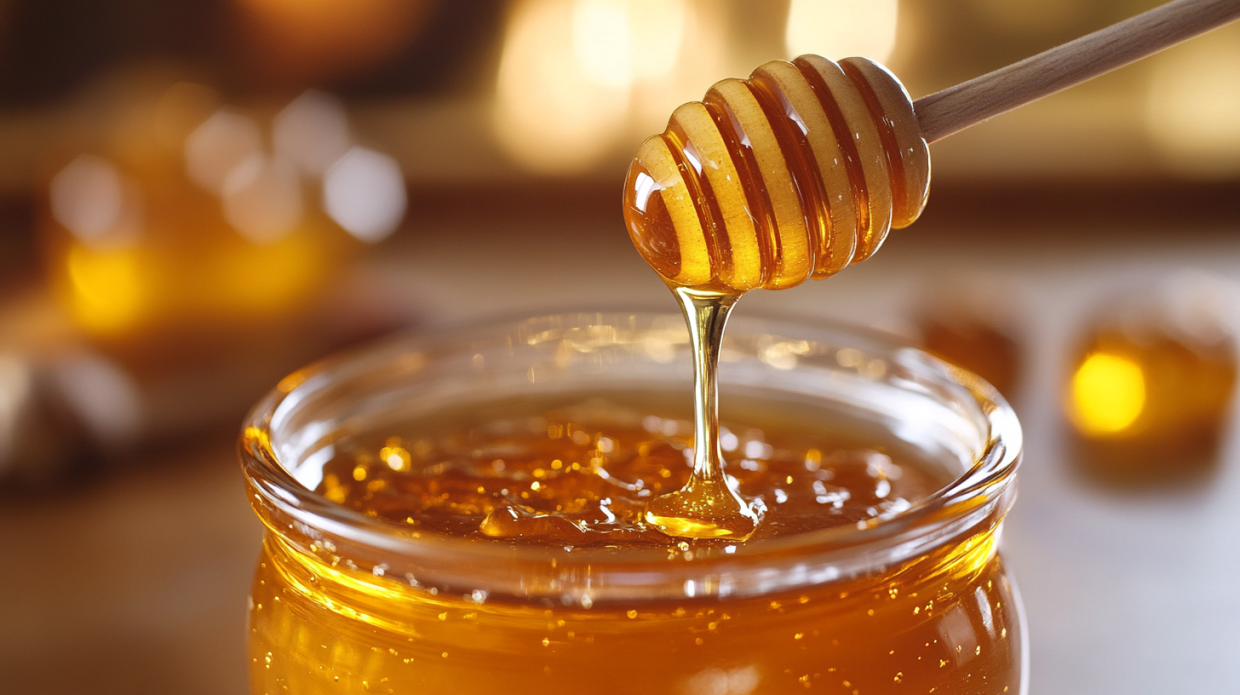
Kirkland Signature Protein Bar, Variety Pack, 2.12 oz, 20-count
- 10-Chocolate Chip Cookie Dough
- 10-Chocolate Brownie
- Made with Real Chocolate
- Gluten Free
- Kosher Dairy
Unwrapping the Truth About Your Favorite Warehouse Club Protein Snack
When the mid-afternoon energy slump hits or you need something substantial to tide you over between meals, Kirkland Signature protein bars have become the go-to solution for budget-conscious health enthusiasts. These Costco staples have developed something of a cult following, but how much do you really know about them? Are they truly as nutritious as they claim to be, or just another processed snack masquerading as health food?
As someone who’s spent years analyzing nutrition labels and testing virtually every protein bar on the market, I’ve developed a love-hate relationship with these convenient snacks. Let’s dive deep into everything Kirkland bars have to offer, from nutrition facts to flavor profiles, cost comparisons, and whether they deserve a place in your pantry or gym bag.
The Kirkland Bar Lineup: More Than Just Protein
Most people familiar with Costco’s Kirkland Signature brand immediately think of their protein bars, but the lineup is actually more diverse than you might realize. Let’s break down the main categories:
Kirkland Signature Protein Bars
The flagship product that put Kirkland on the protein bar map comes in a distinctive red box. These bars are positioned as direct competitors to more expensive options like Quest bars, with similar macronutrient profiles but at a fraction of the cost.
Kirkland Signature Protein Bar Minis
Introduced more recently, these smaller versions offer portion control for those who find the original bars too large or calorie-dense. Perfect for a light snack rather than a meal replacement.
Kirkland Signature Granola Bars
Not to be confused with their protein-focused cousins, these traditional granola bars come in variety packs and target a different consumer looking for a simple, sweet snack rather than a protein boost.
Kirkland Signature Nut Bars
For those prioritizing healthy fats over protein, these nut-based bars provide a crunchy alternative with minimal added sugars.
Now that we know the players, let’s focus primarily on the most popular option: the Kirkland Signature Protein Bars.
Nutrition Breakdown: What’s Really in Kirkland Protein Bars?
The standard Kirkland Protein Bar weighs in at 60 grams and delivers approximately:
- 21 grams of protein (primarily from milk protein isolate and whey protein isolate)
- 4 grams of net carbs
- 7 grams of fat
- 190-200 calories (depending on flavor)
- 15 grams of fiber
- 1 gram of sugar
- 8-9 grams of sugar alcohols
At first glance, this nutritional profile looks impressive. The high protein content supports muscle recovery, while the fiber helps promote satiety. The minimal sugar content appears to make them friendly for those watching their sugar intake.
However, it’s worth noting that these bars contain several sugar alcohols (primarily erythritol) and soluble corn fiber to achieve their sweet taste with minimal impact on blood sugar. For some people, these ingredients can cause digestive discomfort, especially when consumed regularly.
Ingredient Deep Dive: The Good, The Bad, and The Questionable
Let’s take a closer look at what goes into these popular bars:
The Base Ingredients
The foundation of most Kirkland Protein Bars includes:
- Protein blend (milk protein isolate, whey protein isolate)
- Soluble corn fiber
- Almonds
- Water
- Erythritol
- Natural flavors
- Unsweetened chocolate (in chocolate varieties)
- Cocoa butter
- Casein
The Additives
Additional ingredients that vary by flavor may include:
- Sea salt
- Sunflower lecithin
- Steviol glycosides (stevia)
- Sucralose
- Gellan gum
- Citric acid
Potential Red Flags
While not necessarily problematic for everyone, some ingredients may cause issues for certain individuals:
- Sugar alcohols (erythritol) – can cause digestive discomfort in some people
- Artificial sweeteners (sucralose) – controversial for potential effects on gut health and metabolism
- Soluble corn fiber – may cause bloating or gas in sensitive individuals
- Milk proteins – problematic for those with dairy sensitivities
It’s worth noting that Kirkland Protein Bars are not vegan, as they contain milk-derived proteins. They’re also manufactured in facilities that process soy and eggs, making them potentially problematic for those with severe allergies.
Flavor Varieties: Which Kirkland Bar Tastes Best?
The original Kirkland Signature Protein Bars come in four main flavors:
- Chocolate Chip Cookie Dough
- Chocolate Brownie
- Cookies & Cream
- Chocolate Peanut Butter Chunk
More recently, Costco has introduced seasonal or regional flavors in some locations, including:
- Cinnamon Roll
- S’mores
- Chocolate Mint
Among regular consumers, Chocolate Brownie and Chocolate Peanut Butter Chunk consistently rank as fan favorites. The Cookie Dough flavor tends to be more divisive – some love it, while others find the artificial sweetener taste more pronounced.
The texture of these bars is dense and chewy, similar to Quest bars but slightly softer. They don’t have the chalky quality that plagues many protein bars, but they do have a distinctive mouthfeel that comes from the fiber and protein content.
The Price Factor: Kirkland’s Major Competitive Advantage
Perhaps the most compelling selling point for Kirkland Protein Bars is their cost. Let’s break down the numbers:
- Kirkland Protein Bars: Approximately $17.99-$19.99 for 20 bars ($0.90-$1.00 per bar)
- Quest Bars: Approximately $24.99 for 12 bars ($2.08 per bar)
- ONE Bars: Approximately $23.99 for 12 bars ($2.00 per bar)
- Pure Protein: Approximately $18.99 for 12 bars ($1.58 per bar)
This makes Kirkland bars less than half the price of leading competitors like Quest, while offering very similar nutritional profiles. For budget-conscious consumers, especially those who consume protein bars regularly, the savings can amount to hundreds of dollars per year.
The value proposition becomes even more appealing when Costco runs occasional sales, dropping the price to around $15.99 per box.
Health Considerations: Are Kirkland Bars Actually Good For You?
The answer to whether Kirkland Protein Bars are “healthy” depends largely on your individual needs, dietary preferences, and how you incorporate them into your overall eating pattern.
Potential Benefits:
- High protein content supports muscle recovery and growth
- High fiber content promotes satiety and digestive health
- Low sugar content makes them appropriate for those monitoring blood sugar
- Convenient source of balanced macronutrients when whole foods aren’t available
- More affordable than many nutritional supplements
Potential Drawbacks:
- Highly processed with multiple additives
- Artificial sweeteners may affect gut health or trigger cravings in some people
- Sugar alcohols can cause digestive discomfort
- Not whole foods and shouldn’t replace naturally nutrient-dense options
- Contains dairy and isn’t suitable for vegans or those with milk allergies
Special Dietary Considerations
Gluten-Free Status: While Kirkland Protein Bars don’t contain gluten ingredients, they’re not certified gluten-free and may be processed in facilities that handle gluten. Those with celiac disease should proceed with caution.
Keto-Friendly?: With just 4 grams of net carbs, these bars are considered keto-compatible by many following the diet. However, purists might avoid them due to the maltitol and other ingredients.
Weight Loss: The high protein and fiber content can make these bars supportive of weight loss efforts by promoting fullness, but they still contain 190-200 calories, which must be factored into overall intake.
Kirkland vs. Quest: The Ultimate Protein Bar Showdown
Given that Kirkland Protein Bars are often viewed as “Quest knockoffs,” how do they actually compare?
Nutrition Comparison
| Kirkland Protein Bar | Quest Bar | |
|---|---|---|
| Calories | 190-200 | 180-200 |
| Protein | 21g | 20-21g |
| Net Carbs | 4g | 4-5g |
| Fiber | 15g | 14-15g |
| Sugar | 1g | <1g |
| Sugar Alcohols | 8-9g | 5-7g |
| Price per bar | $0.90-$1.00 | $2.00-$2.50 |
As you can see, the nutritional profiles are remarkably similar. The main differences come down to:
- Taste and texture: Quest offers more flavors and some fans prefer their texture
- Sweetener blend: Slightly different combinations of erythritol, stevia, and sucralose
- Availability: Quest is available in more retailers beyond Costco
- Price: Kirkland bars cost less than half as much
For most consumers, the decision comes down to accessibility (whether you have a Costco membership), taste preference, and budget.
Real-World Applications: How to Use Kirkland Bars Effectively
Knowing when and how to incorporate protein bars into your routine can help you maximize their benefits while minimizing any downsides.
As a Post-Workout Recovery Snack
With 21 grams of protein, Kirkland bars provide sufficient protein to stimulate muscle protein synthesis after resistance training. The combination of whey and milk proteins offers both rapid and sustained amino acid delivery. The minimal fat content won’t slow digestion significantly, allowing the protein to get to work quickly.
As a Meal Replacement
While not ideal as a regular substitute for whole food meals, Kirkland Protein Bars can serve as occasional meal replacements when you’re in a pinch. To make them more balanced, consider pairing with a piece of fruit or vegetables for additional micronutrients.
As a Pre-Workout Snack
The moderate calorie count and digestible protein make these bars suitable for pre-workout nutrition, though some people may find the fiber content too filling before intense exercise. Consider eating them at least 60-90 minutes before training.
For Travel and Emergencies
Perhaps the most practical use for Kirkland Protein Bars is as a travel-friendly, non-perishable option for when healthy food choices are limited. Keeping a bar in your car, desk drawer, or bag can prevent the desperate drive-thru visit when hunger strikes unexpectedly.
Consumer Reviews: What Real Users Say About Kirkland Bars
After analyzing hundreds of online reviews and social media comments, certain themes emerge about consumer experiences with Kirkland Protein Bars:
Positive Feedback:
- “Tastes remarkably similar to Quest but at half the price.”
- “Perfect for my keto lifestyle, keeps me full for hours.”
- “The chocolate brownie flavor is actually delicious, not just tolerable like most protein bars.”
- “Haven’t found a better value in the protein bar market.”
- “Doesn’t have that artificial protein aftertaste that many bars do.”
Critical Feedback:
- “Caused significant bloating and gas for the first week until my body adjusted.”
- “The sweetness is overwhelming, tastes very artificial to me.”
- “Too chewy, feels like I’m going to pull out a filling.”
- “Doesn’t taste anything like the flavor it claims to be.”
- “The high fiber content wreaks havoc on my digestive system.”
The mixed reviews highlight how individual responses to these bars can vary dramatically, particularly when it comes to digestive tolerance and taste preferences.
Purchasing Guide: Maximizing Your Kirkland Bar Investment
Where to Buy
While Costco is the primary retailer for Kirkland Signature products, there are other options:
- Costco Warehouses: The most reliable source and typically offers the best pricing
- Costco.com: Available for online purchase, though sometimes at slightly higher prices
- Amazon: Resellers offer Kirkland bars, but usually at a significant markup
- eBay and other marketplaces: Variable pricing and authenticity concerns
Storage Tips
To maintain optimal freshness and prevent the bars from becoming too hard:
- Store in a cool, dry place away from direct sunlight
- Don’t refrigerate (makes them too firm)
- If purchasing in bulk, consider freezing some bars for longer-term storage
- Check expiration dates when buying – they typically have a shelf life of 8-12 months
DIY Alternatives: Homemade Protein Bar Options
If you appreciate the convenience of Kirkland bars but prefer more control over ingredients, consider these simple homemade alternatives:
Basic No-Bake Protein Bars
Ingredients:
- 2 cups rolled oats
- 4 scoops protein powder of choice
- 1/2 cup natural nut butter
- 1/3 cup honey or maple syrup
- 1/4 cup mini dark chocolate chips
- 1 tsp vanilla extract
- Pinch of salt
Method:
- Mix dry ingredients in a large bowl
- Warm nut butter and sweetener, then add to dry ingredients
- Press into a parchment-lined baking dish
- Refrigerate until firm, then cut into bars
These won’t have the same macronutrient profile as Kirkland bars but offer a less processed alternative with customizable ingredients.
The Future of Kirkland Bars: What’s Next?
Based on market trends and Costco’s pattern of product development, we might anticipate several developments in the Kirkland bar lineup:
- Plant-based protein options: As the vegan and plant-based markets grow, a dairy-free Kirkland protein bar seems likely
- Functional additives: Incorporation of adaptogens, probiotics, or other trending health ingredients
- Reduced environmental impact packaging: Moving away from individual plastic wrappers toward more sustainable options
- Expanded flavor varieties: Following the pattern of competitors with seasonal or limited-edition flavors
The protein bar market continues to evolve rapidly, and Costco has demonstrated its commitment to keeping Kirkland products competitive both in quality and pricing.
Conclusion: Are Kirkland Bars Worth Adding to Your Cart?
After thoroughly examining Kirkland Protein Bars from every angle – nutrition, ingredients, taste, cost, and practical applications – the verdict is nuanced.
For most consumers, Kirkland Protein Bars represent an exceptional value in the protein bar market, offering nutrition comparable to premium brands at a fraction of the cost. They serve as a convenient, portable protein source that can support various fitness and lifestyle goals when used appropriately.
However, they’re not for everyone. Those with sensitive digestive systems may struggle with the fiber and sugar alcohol content. Vegans, those with dairy allergies, or people avoiding artificial sweeteners will need to look elsewhere. And for those who prioritize whole, minimally processed foods above all else, even the best protein bar remains a compromise.
Like most nutrition decisions, the choice comes down to your personal priorities, preferences, and how these bars fit into your overall dietary pattern. If you decide they deserve a place in your pantry, that red box from Costco might just be one of the smartest additions to your nutritional arsenal – offering convenience, protein, and value in one chewy package.
Remember that no protein bar, no matter how well-formulated, replaces the importance of a diet centered around whole, nutrient-dense foods. Kirkland bars should complement, not replace, a thoughtful approach to nutrition.
Have you tried Kirkland Protein Bars? What’s your favorite flavor, and how do you incorporate them into your routine? The protein bar debate continues, but one thing’s certain – Costco’s contribution to the category has raised the bar for value in the functional food market.




